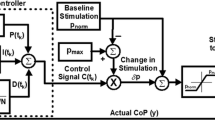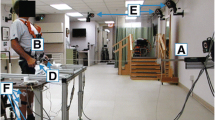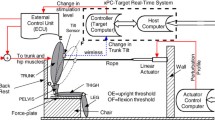Abstract
In this simulation study, we present and examine methods to develop a feedback controller for a neuroprosthesis that restores forward and side leaning function during standing following complete thoracic-level spinal cord injury. Achieving leaning postures away from erect stance with functional neuromuscular stimulation (FNS) would allow users to extend their reaching capabilities. Utilizing a 3-D computer model of human stance, an FNS control system based on total-body center of mass (CoM) kinematics (position, acceleration) is developed and tested in simulation. CoM kinematics drive an artificial neural network to modulate muscle excitations and reduce the upper extremity loading, presumably against a walker or similar support surface, required to resist the effects of postural perturbations. Furthermore, a novel method to robustly estimate the feedback kinematics for standing applications is also presented while assuming 3-D accelerometer signals at locations consistent with a proposed implantable networked neuroprosthesis system. For shifting and balance at leaning postures, respectively, center of mass position and acceleration could be approximated to within 20 % of the maximum value, with strong correlations (R > 0.9) between values estimated by the proposed method and the true values derived from model dynamics. When utilizing the estimated feedback kinematics for FNS control, standing performance in terms of maximum upper extremity loading was still significantly reduced (p < 0.001) compared to conventionally applying constant and maximal stimulation. In the future, these simulation-based methods will be employed to develop experimental approaches for restoring leaning standing function by FNS.






Similar content being viewed by others
References
Amankwah K, Triolo RJ, Kirsch R (2004) Effects of spinal cord injury on lower-limb passive joint moments revealed through a nonlinear viscoelastic model. J Rehabil Res Dev 41(1):15–32
Audu ML et al (2011) Posture shifting after spinal cord injury using functional neuromuscular stimulation—a computer simulation study. J Biomech 44(9):1639–1645
Audu ML et al (2014) Posture-dependent control of stimulation in standing neuroprosthesis: simulation feasibility study. J Rehabil Res Dev 51(3):481–496
Bhadra N, Kilgore KL, Peckham PH (2001) Implanted stimulators for restoration of function in spinal cord injury. Med Eng Phys 23(1):19–28
Cavanaugh JT et al (1999) Kinematic characterization of standing reach: comparison of younger vs older subjects. Clin Biomech (Bristol, Avon) 14(4):271–279
Craig JJ (2005) Introduction to robotics: mechanics and control, vol 3. Pearson Prentice Hall, Upper Saddle River
Crowninshield RD, Brand RA (1981) A physiologically based criterion of muscle force prediction in locomotion. J Biomech 14(11):793–801
Davis JA Jr et al (2001) Preliminary performance of a surgically implanted neuroprosthesis for standing and transfers—where do we stand? J Rehabil Res Dev 38(6):609–617
Eames M, Cosgrove A, Baker R (1999) Comparing methods of estimating the total body centre of mass in three-dimensions in normal and pathological gaits. Hum Mov Sci 18(5):637–646
Gray GA, Golda TG (2006) Algorithm 856: APPSPACK 4.0: asynchronous parallel pattern search for derivative-free optimization. ACM Trans Math Softw 32:12
Ho CH et al (2014) Functional electrical stimulation and spinal cord injury. Phys Med Rehabil Clin N Am 25(3):631–654
Horak FB, Nashner LM (1986) Central programming of postural movements: adaptation to altered support-surface configurations. J Neurophysiol 55(6):1369–1381
Jovic J et al (2015) Coordinating upper and lower body during FES-assisted transfers in persons with spinal cord injury in order to reduce arm support. Neuromodulation. doi:10.1111/ner.12286
Kagaya H et al (1998) Ankle, knee, and hip moments during standing with and without joint contractures: simulation study for functional electrical stimulation. Am J Phys Med Rehabil 77(1):49–54 quiz 65–6
Kim JY, Popovic MR, Mills JK (2006) Dynamic modeling and torque estimation of FES-assisted arm-free standing for paraplegics. IEEE Trans Neural Syst Rehabil Eng 14(1):46–54
Kuo AD, Zajac FE (1993) A biomechanical analysis of muscle strength as a limiting factor in standing posture. J Biomech 26(Suppl 1):137–150
Lambrecht JM et al (2009) Musculoskeletal model of trunk and hips for development of seated-posture-control neuroprosthesis. J Rehabil Res Dev 46(4):515–528
Luinge HJ, Veltink PH (2004) Inclination measurement of human movement using a 3-D accelerometer with autocalibration. IEEE Trans Neural Syst Rehabil Eng 12(1):112–121
Lynch CL, Popovic MR (2012) A comparison of closed-loop control algorithms for regulating electrically stimulated knee movements in individuals with spinal cord injury. IEEE Trans Neural Syst Rehabil Eng 20(4):539–548
Nataraj R (2011) Feedback control of standing balance using functional neuromuscular stimulation following spinal cord injury, in biomedical engineering. Case Western Reserve University, Cleveland, p 466
Nataraj R et al (2010) Comprehensive joint feedback control for standing by functional neuromuscular stimulation-a simulation study. IEEE Trans Neural Syst Rehabil Eng 18(6):646–657
Nataraj R et al (2012) Center of mass acceleration feedback control for standing by functional neuromuscular stimulation: a simulation study. J Rehabil Res Dev 49(2):279–296
Nataraj R, Audu ML, Triolo RJ (2012) Comparing joint kinematics and center of mass acceleration as feedback for control of standing balance by functional neuromuscular stimulation. J Neuroeng Rehabil 9:25
Nataraj R, Audu ML, Triolo RJ (2012) Center of mass acceleration feedback control of functional neuromuscular stimulation for standing in presence of internal postural perturbations. J Rehabil Res Dev 49(6):889–911
Nataraj R, Audu ML, Triolo RJ (2013) Center of mass acceleration feedback control of standing balance by functional neuromuscular stimulation against external postural perturbations. IEEE Trans Biomed Eng 60(1):10–19
Nataraj R, Audu ML, Triolo RJ (2014) Modified Newton–Raphson method to tune feedback gains of control system for standing by functional neuromuscular stimulation following spinal cord injury. Appl Bionics Biomech 11(4):169–174
Peckham PH (2009) Neuromodulation: implantable neural stimulators. Elsevier Ltd, Amsterdam
Riess J, Abbas JJ (2001) Adaptive control of cyclic movements as muscles fatigue using functional neuromuscular stimulation. IEEE Trans Neural Syst Rehabil Eng 9(3):326–330
Rietdyk S et al (1999) NACOB presentation CSB New Investigator Award. Balance recovery from medio-lateral perturbations of the upper body during standing. North American Congress on Biomechanics. J Biomech 32(11):1149–1158
Uhlir JP, Triolo RJ, Kobetic R (2000) The use of selective electrical stimulation of the quadriceps to improve standing function in paraplegia. IEEE Trans Rehabil Eng 8(4):514–522
Winter DA (2009) Biomechanics and motor control of human movement. Wiley, New York
Winter DA et al (1998) Stiffness control of balance in quiet standing. J Neurophysiol 80(3):1211–1221
Zajac FE (1989) Muscle and tendon: properties, models, scaling, and application to biomechanics and motor control. Crit Rev Biomed Eng 17(4):359–411
Zhao W et al (1998) A bipedal, closed-chain dynamic model of the human lower extremities and pelvis for simulation-based development of standing and mobility neuroprostheses. In: Proceedings of the 20th annual international conference of the IEEE Engineering in Medicine and Biology Society, 1998, Hong Kong, China
Acknowledgments
The project described was supported by Grant Number R01NS040547 from NINDS/NIH, and T32AR00750525 from NIAMS/NIH. Its contents are solely the responsibility of the authors and do not necessarily represent the official views of the NIAMS or NIH. The research described here was supported in part by the Department of Veterans Affairs, Veterans Health Administration, Rehabilitation Research and Development Service—Award No. A9259-L. The research was approved by VA IRB #2008-027.
Author information
Authors and Affiliations
Corresponding author
Rights and permissions
About this article
Cite this article
Nataraj, R., Audu, M.L. & Triolo, R.J. Simulating the restoration of standing balance at leaning postures with functional neuromuscular stimulation following spinal cord injury. Med Biol Eng Comput 54, 163–176 (2016). https://doi.org/10.1007/s11517-015-1377-5
Received:
Accepted:
Published:
Issue Date:
DOI: https://doi.org/10.1007/s11517-015-1377-5




